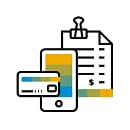Growth and Optimization
What Are Industry Benchmarks for Accounts Payable Efficiency?
Time is money and accounts payable departments are continuously looking for ways to optimise cashflow by avoiding late fees, taking advantage of early payments, or negotiating better pricing and delivery terms with suppliers. Evaluation of the optimal amount of time between when these expenses are submitted, approved, and paid -- what we call spend governance -- is an indicator of whether an AP process is as efficient as it could be.
Barriers to Accounts Payable Efficiency
Increasing the rate at which expenses are submitted, approved, and paid isn’t as simple as posting payments more quickly. Top challenges for AP processes include:
-
Poor data entry and errors
-
Inefficient storage
-
Slow processing
-
Lost invoices
-
Ineffective fraud prevention
-
Lost cash
-
Exception invoice volumes
Because accounts payable's core function is to pay only the organisation’s expenses that are legitimate and accurate, challenges like these must be resolved before payments can be issued. Delayed payments can result in finance charges, unhappy employees, or poor supplier relations. Further consequences of delayed payments may result in delays in supply of future goods, downgrading of credit rating, adverse impact of manufacturing and shipment schedules and associated revenue, as well as dissatisfied customers or employees.
Inversely, paying suppliers too early can also impact a company’s ability to meet other financial obligations due to reduced cash flow. That’s why leveraging industry benchmarks to create a timeline that factors in all these elements can create and gauge an efficient AP process.
Evaluate Your AP Process
The "time-to-pay" metric starts from the moment when the first expense is approved to when it is marked as paid in your system. Optimise your time-to-pay to have a positive impact on your organisation’s cash position, credit rating, relationships with suppliers, and accuracy of corporate financial reports. Not only that, you also need to meet local government requirements, such as the Duty to Report on Payment Practices in the UK, on payment timelines. Look at your back-office processes as a starting point to uncovering inefficiency.
Industry Benchmarks
SAP Concur experts recommend keeping your overall time-to-pay between two days to approve and three days to pay. Here are some other best practice benchmarks Concur Invoice users experience. See if you’re on-track, or need to help you adjust your timelines in order to make your process more efficient:
-
Best-in-class UK companies (with under 1,000 employees) who are turning to digital technology to automate finance processes, are seeing 24% faster time to receive and process supplier invoices
-
42% reductions in the number of delayed payments
-
12 hours saved per AP employee a week
-
Concur Invoice users typically experience a three-year ROI of 634% and four-month payback period
-
Average savings for Concur Invoice users are £109,200 on accounts payable-related costs
How to Get Started
Take a look at our AP Toolkit for a wealth of resources to get you started on the path to efficient invoice automation.

